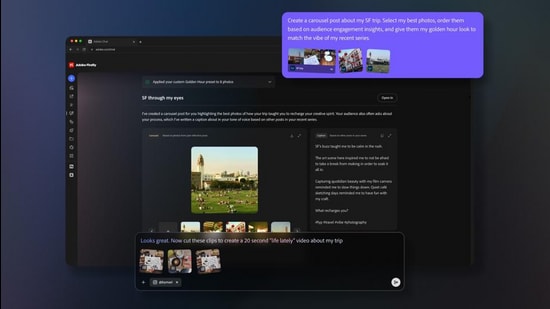At a time when there is a sense of ambiguity about the best way forward with autonomous agents in the workplace, Adobe, at the tech company’s flagship MAX keynote, insists a focused approach for Agentic AI experiences across its creative apps is key. They believe agentic capabilities must complement and not attempt to replace the core strengths of apps such as Photoshop or Express. With agentic features finding their way into Photoshop, Express and also exploring links with popular artificial intelligence (AI) chatbots such as OpenAI’s ChatGPT, Adobe hopes its implementation will enhance prompting and editing. The world also got a first glimpse of Project Moonlight, envisioned as a creative assistant that can coordinate across Adobe’s apps, which is launching in a private beta at this time.
In Adobe Express, be it on the web or the app, this AI assistant is expected to hasten the process from concept to creation. In the Photoshop app, Adobe says it’ll “empower creative professionals with even more control, power and potential time-savings”. This, will be rolled out basis a beta version wait list. “In Photoshop Web, we’re introducing a conversational panel where you can actually talk to Photoshop, and tell it to do things for you. It will understand what tools to use, select subject, and keep it completely editable”, the company says.
Adobe says that are also exploring ways in which they can bring conversational experiences with popular chatbots, including OpenAI’s ChatGPT. The first app, demoed at the MAX keynote, is Express, allowing the chatbot to search for templates and select them, modify based on prompt and access certain Express tools to do tasks. Adobe insists that agentic AI needs to happen inside the user’s apps, and that they are taking the creative apps where the agents are.
Project Moonlight is expected to find relevance as a creative partner that will assistant with ideation and coordination across the other Adobe apps that you may be using. The company visualises this as something that can understand an idea, decode a particular creative profile and be an assistant that can travel with a user across Adobe’s applications and learn from as well as be able to access assets stored in Adobe Cloud.
Earlier in the year, Govind Balakrishnan, senior vice president for Express Product Group & Digital Media Services at Adobe, told HT in a conversation that conversation around building AI agents are essentially an “opportunity that we have is to essentially reimagine and rethink creativity.” Customisable AI assistants aren’t a new idea to Adobe — this is something they have already embedded in the Acrobat Studio, where these assistants draw information, answers and recommendations from the user’s hub of documents and content.
Updates for Creative Cloud and more
While the focus of the MAX keynote for this year centres around widening access of AI models for subscribers and the first steps towards Agentic AI within Adobe’s apps, the company has not missed a chance to add new functionality to its popular Creative Cloud apps.
Photoshop’s popular generative fill capabilities will now be able to rely on two new partner AI models, Google’s Gemini 2.5 Flash and Black Forest Labs FLUX.1 Kontext. Both have different traits and strong elements — Nano Banana is optimised for preserving details which makes it ideal for creative transformations, while FLUX.1 Kontext is conversational and helps maintain character consistency and precise edits. It is likely you’ll need to update the Photoshop app to access these new models.
Adobe Lightroom is adding something called Assisted Culling, which is expected to help photographers quickly identify the best images to work with. This AI capability was first teased over the summer, it will rely on a number of metrics including subject focus, eyes focus, and eyes open detection to help choose the best photo from a similar group, which should help get to the process of editing faster.
